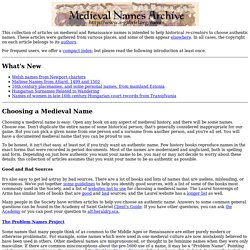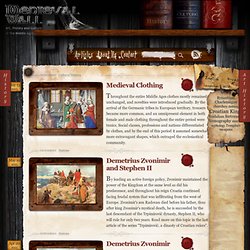

Medieval Names Archive. This collection of articles on medieval and Renaissance names is intended to help historical re-creators to choose authentic names.

These articles were gathered from various places, and some of them appear elsewhere. In all cases, the copyright on each article belongs to its authors. For frequent users, we offer a compact index; but please read the following introduction at least once. What's New Choosing a Medieval Name Choosing a medieval name is easy: Open any book on any aspect of medieval history, and there will be some names. To be honest, it isn't that easy. at least not if you truly want an authentic name. Good and Bad Sources It's also easy to get led astray by bad sources. Food and Cookery Books - Classical, Dark Age, Medieval - Stuart Press. Recipes at Medieval.Net. Medieval Gastronomy - Cooking.
TimeRef - Medieval and Middle Ages History Timelines for kids and adults. Medieval Wall - Art, history and culture of the Middle Ages - Part 2. May 13 2013 Categories: Cultural History Medieval Clothing Throughout the entire Middle Ages clothes mostly remained unchanged, and novelties were introduced gradually.

By the arrival of the Germanic tribes to European territory, trousers became more common, and an omnipresent element in both female and male clothing throughout the entire period were tunics. Social classes, professions and nations differentiated by clothes, and by the end of this period it assumed somewhat more extravagant shapes, which outraged the ecclesiastical community. May 10 2013 Categories: Nations Demetrius Zvonimir and Stephen II By leading an active foreign policy, Zvonimir maintained the power of the Kingdom at the same level as did his predecessor, and throughout his reign Croatia continued facing feudal system that was infiltrating from the west of Europe.
Apr 20 2013 Demetrius Zvonimir Apr 07 2013 Petar Krešimir IV After his ascension to the throne, Peter Krešimir IV was faced with the ongoing schism. Medieval Sword Scabbard How to Project. When are satisfied with the fit then you are ready to glue the two halves together.

If you wish you can cut the outside shape before you glue them together, or you can cut them as one piece after you glue them together. Whichever way you choose, be sure that you leave enough room around the core so you don't cut into the grove you have chisled out. You may wish to center the blade on the outside of the core and draw around it as a guide. If you are using a chape don't forget that you will need to take this into account when shaping the core. I sanded mine until the chape was just a little loose, so it would fit over the leather.
A Historic Method The "Slat" method project shown below and all the photos are by Jean Le-Palud of France. According to Peter Johnsson, and I quote, "Thin slats of wood that are formed over the blade (either formed by steaming/soaking or by cutting), or layers of veneer glued in layers on each side can be seen on surviving examples.
Medieval Swords and Weapons. Honfoglalas.gif (Изображение GIF, 1014 × 728 пиксела) Books and Films - Terry Jones' Medieval Lives. The History Of English In 10 Minutes. The Most Painful Torture Devices Of The Middle Ages. The Ultimate Torture Devices: The Rack Probably the most commonly know torture device from the Middle Ages, the rack was a wooden platform, with rollers at both ends.

The victim’s hands and feet were tied to each end and the rollers would be turned, stretching the victim’s body to uncomfortable lengths. Painful Torture Devices: Knee Splitter Used frequently during the Spanish Inquisition, the knee splitter, naturally, was used to split a victims knee. The device was built from two spiked wood blocks with a screw at the back, and was clamped on the front and back of the knee.